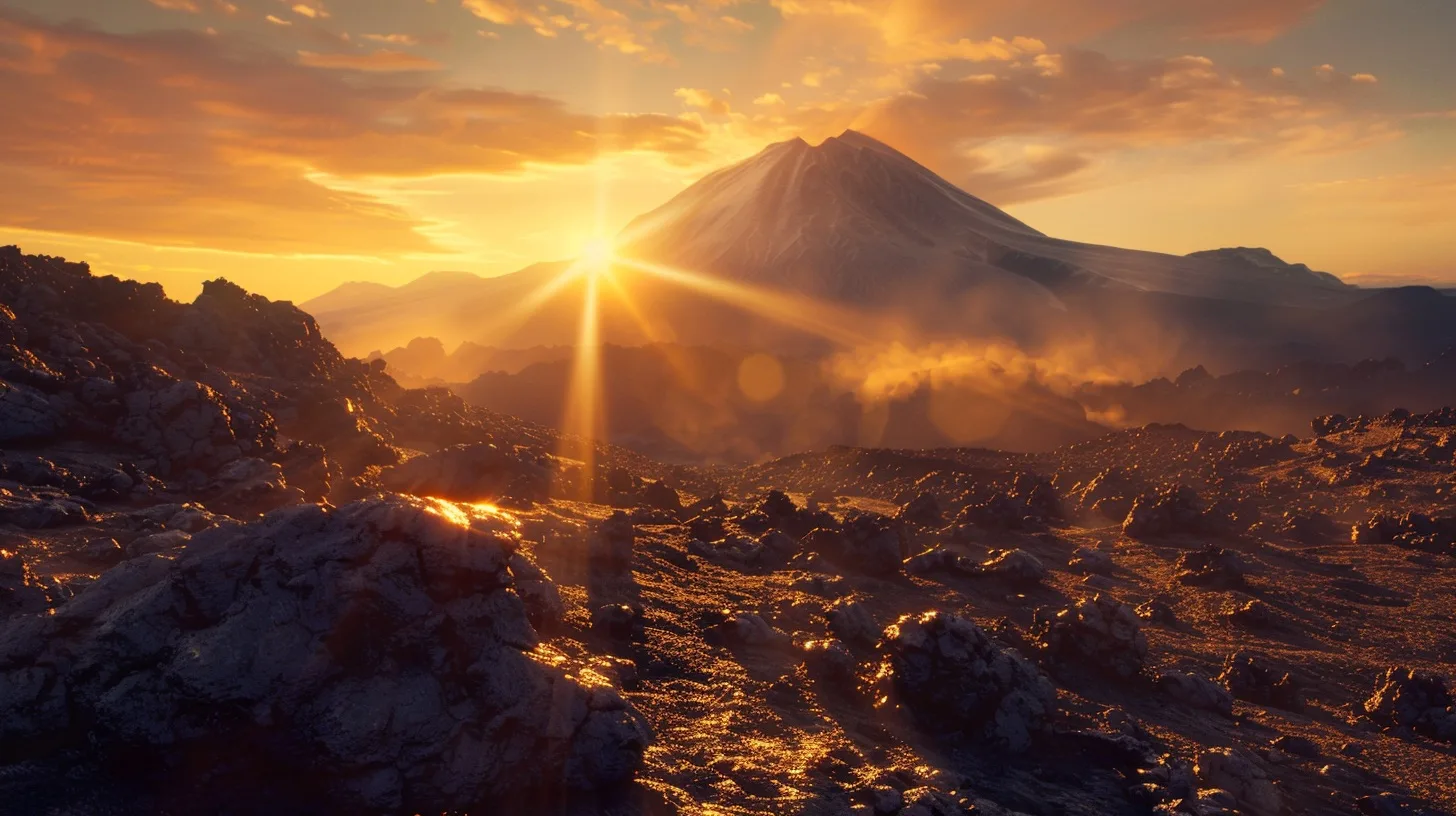Nestled within the vibrant landscapes of Guatemala, Volcán de Fuego stands as a testament to nature’s awe-inspiring power and beauty. This active stratovolcano, “Volcano of Fire,” is one of Central America’s most iconic and dynamic natural wonders. With its near-constant activity, Volcán de Fuego offers a rare opportunity to witness Earth’s raw energy up close, making it a must-visit destination for adventurers and nature enthusiasts alike.
The Significance of Volcán de Fuego in Guatemala
- Cultural Heritage: Volcán de Fuego holds profound cultural significance for the local communities, intertwined with their history, myths, and daily lives.
- Scientific Interest: Its frequent eruptions make it a hotspot for volcanologists and geologists worldwide, eager to study its behaviour and contribute to our understanding of volcanic activity.
- Economic Impact: The fertile soils surrounding the volcano support rich agriculture, contributing to the local economy with crops such as coffee, known for their exceptional quality.
Why Volcán de Fuego Captivates Adventurers and Nature Lovers
Seeing glowing lava flows, ash plumes, and pyroclastic clouds offers an unforgettable spectacle, especially at night.
The trails around Volcán de Fuego challenge and reward hikers with stunning vistas of the surrounding landscapes and the neighbouring volcanoes, Acatenango and Agua.
The diverse ecosystems around the volcano are home to an array of wildlife, offering birdwatchers and nature photographers a rich field for exploration.
Visiting Volcán de Fuego provides a unique chance to engage with local communities, learn about their traditions, and experience the warmth of Guatemalan hospitality.
Embarking on a journey to Volcán de Fuego is more than an adventure; it’s an immersion into the heart of Guatemala’s natural majesty and cultural richness. Whether you’re drawn by the thrill of hiking an active volcano, the beauty of the surrounding landscapes, or the chance to connect with local traditions, Volcán de Fuego promises an experience that resonates long after you’ve returned home.
The Majesty of Volcán de Fuego: Guatemala’s Towering Beacon
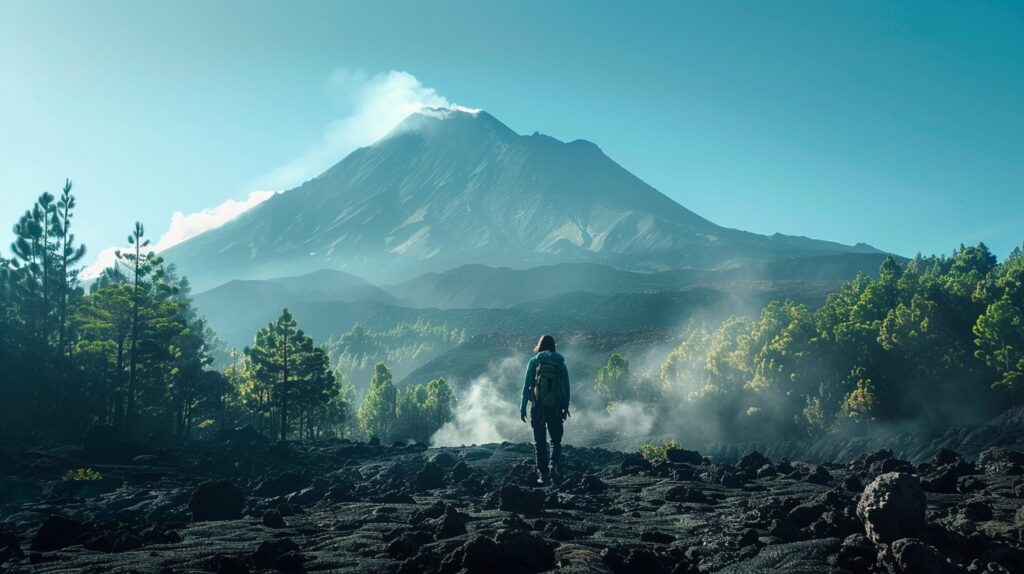
Nestling among Guatemala’s highlands, Volcán de Fuego is more than just a geological marvel; it symbolizes nature’s untamed spirit. This active stratovolcano, part of the Central American Volcanic Arc, has captured the imagination of locals and travellers alike with its frequent eruptions and the breathtaking landscapes it dominates.
A Glimpse into Volcán de Fuego’s Past and Present
With a history of eruptions dating back to the Spanish Conquest, Volcán de Fuego has actively shaped the region’s geography and culture. Its presence is a constant reminder of the Earth’s dynamic nature.
Known for its almost constant activity, Volcán de Fuego has experienced numerous eruptions in the 21st century, with significant events impacting nearby communities and drawing global attention to Guatemala’s volcanic activity.
The Volcano’s Unique Geographical and Ecological Tapestry
Standing at an impressive height of over 12,000 feet, Volcán de Fuego is part of a trio with its dormant sister volcano, Acatenango, and the extinct Volcán de Agua. This trio forms a stunning backdrop to the Antigua, Guatemala valley, offering an unparalleled scenic vista.
The slopes of Volcán de Fuego support diverse ecosystems, ranging from lush cloud forests at lower altitudes to sparse, volcanic rock landscapes near the summit. This variety fosters a unique biodiversity hotspot, home to many species of birds, mammals, and plants adapted to varying climates and soils.
The fertile volcanic soils around Fuego are prized for agriculture, particularly coffee cultivation, which thrives in the mineral-rich ground, producing some of the world’s finest coffee beans.
For adventurers, the volcano presents challenging hikes and the chance to witness volcanic activity up close. For scientists, it offers a living laboratory to study volcanic behaviour, ecosystem adaptation, and the impacts of eruptions on human settlements.
Volcán de Fuego: A Testament to Nature’s Power and Beauty
The majesty of Volcán de Fuego lies not just in its eruptions but in the life it nurtures on its slopes and the cultures that have flourished around it. The volcano’s imposing silhouette, ever-changing with each eruption, tells a story of creation, destruction, and renewal. This cycle fascinates all who venture near. Whether you are drawn to its geological importance, the ecological diversity it supports, or the sheer thrill of exploring one of the world’s most active volcanoes, Volcán de Fuego stands as a monumental testament to the beauty and power of the natural world.
Preparing for Your Adventure: The Optimal Volcán de Fuego Experience
Embarking on a journey to Volcán de Fuego is not only about embracing the thrill of adventure but also about meticulous preparation to ensure a safe and memorable experience. Here’s how to gear up for your encounter with one of Guatemala’s most captivating natural wonders.
Best Times to Visit Volcán de Fuego
- Dry Season Delights: The optimal period for hiking Volcán de Fuego is from November to April in Guatemala’s dry season. During these months, clearer skies and less rainfall provide safer hiking conditions and better views of the volcano’s activity.
- Off-Peak Exploration: Consider planning your visit in the shoulder months, such as early November or late April. You’ll benefit from the dry season’s weather with fewer crowds, offering a more personal connection with the volcano’s majestic presence.
Essential Gear and Preparation Tips
Embarking on a trek to Volcán de Fuego demands thoughtful preparation in terms of physical readiness and the gear you bring along. Here are the essentials to keep in mind.
Gear Checklist
- Sturdy Hiking Boots: Invest in a good pair of boots with ankle support and a grip suitable for rocky and uneven terrain.
- Layered Clothing: Weather can be unpredictable. Pack lightweight, breathable layers for the hike and warmer layers for higher altitudes where temperatures drop.
- Rain Gear: Even in the dry season, sudden showers can occur. A waterproof jacket is indispensable.
- Hydration System: Carry at least 2-3 litres of water or a bladder. Staying hydrated is crucial.
- Headlamp and Extra Batteries: A reliable light source is essential if your hike extends into the evening or starts before dawn.
- Sun Protection: Sunscreen, sunglasses, and a hat protect you from the sun’s intensity, especially at higher elevations.
Preparation Tips
- Physical Fitness: The trek to view Volcán de Fuego’s eruptions is demanding. To build stamina and endurance, engage in regular cardio and strength training weeks before your trip.
- Acclimatization: Spend a few days at higher altitudes to acclimate your body, mainly if you’re not used to high-elevation environments.
- Local Guides: Hiring a knowledgeable local guide is highly recommended. They offer invaluable insights into safe routes and current volcanic activity. They can enhance your overall experience with historical and ecological context.
- Check Volcanic Activity: Before setting out, check the latest reports on Volcán de Fuego’s activity. Conditions can change rapidly, and safety should always be your top priority.
- Respect Nature and Local Communities: Be mindful of the environment and communities in the volcano’s vicinity. Follow your guide’s instructions, stick to designated paths, and carry out all trash.
Embracing the Journey
Preparation is the key to unlocking the full majesty of Volcán de Fuego while ensuring your adventure is as safe as it is exhilarating. By choosing the best time to visit, equipping yourself with essential gear, and respecting both the natural environment and local customs, you’re set to experience one of the most unforgettable adventures Guatemala has to offer.
Exploring Volcán de Fuego: A Hiker’s Guide
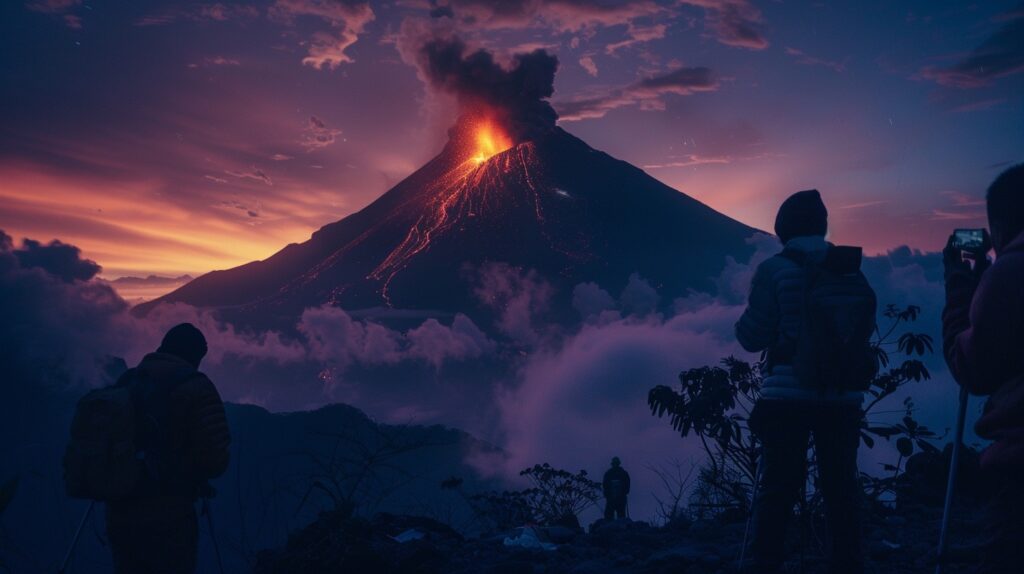
Embarking on a hike to Volcán de Fuego promises an adventure filled with awe-inspiring landscapes and the thrill of being near one of the most active volcanoes in Central America. Here’s your guide to approaching this majestic volcano safely, including popular routes, viewpoints, and essential safety and ethical considerations.
Approaching the Volcano Safely
- Start Early: Begin your hike early to maximize daylight hours and avoid midday heat.
- Stay Informed: Keep up-to-date with the latest volcanic activity reports and weather conditions. Your guide will be a valuable source of this information.
- Travel in Groups: Hiking with others enhances the experience and increases safety.
- Staying on Marked Trails: To minimize environmental impact and ensure safety, stick to the established paths.
Popular Hiking Routes and Viewpoints
La Soledad to Volcán de Fuego Base Camp: This challenging route starts from the village of La Soledad, offering breathtaking views as you ascend. The base camp provides a safe distance to observe the volcanic activity, especially at night when eruptions are most visible.
Acatenango Volcano Twin Peak: For those seeking a less intense experience, hiking the neighbouring Acatenango Volcano offers spectacular views of Fuego’s eruptions. Overnight camping allows for nighttime observation, a truly unforgettable experience.
El Panorama Viewpoint: Accessible by a shorter hike, this viewpoint offers panoramic views of Fuego for those limited by time or seeking a less strenuous journey.
Safety Precautions
- Volcanic Gas Awareness: Be aware of wind direction and avoid areas where volcanic gas is concentrated. Gas masks are recommended for closer observation points.
- Emergency Plan: Have a clear plan in case of sudden eruptions or changes in volcanic activity. Follow your guide’s instructions immediately.
- First Aid Kit: Carry a basic first aid kit for minor injuries. Include essentials such as band-aids, antiseptic wipes, and pain relievers.
Exploring Volcán de Fuego is a privilege that comes with responsibilities—to ensure your safety, protect the environment, and respect the local communities that live in the shadow of this powerful force of nature. By following these guidelines and approaching your adventure with preparedness and respect, your experience at Volcán de Fuego will be as enriching as it is exhilarating.
Staying Solutions Near Volcán de Fuego
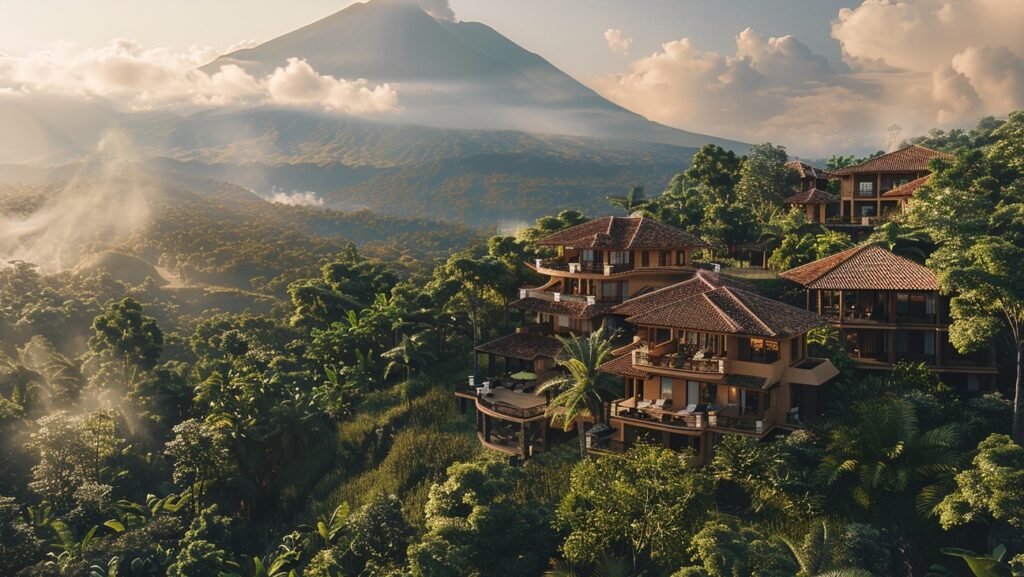
Whether you’re a backpacker on a budget or seeking an indulgent retreat after your adventurous hike, the area around Volcán de Fuego offers a range of accommodations to suit every traveller’s needs. Here’s a breakdown of staying solutions, from budget-friendly options to luxurious escapes.
Budget-Friendly Options
These affordable hostels and guesthouses are perfect for those looking to stretch their dollars without sacrificing comfort and convenience.
Casa Kiwi Hostel La Antigua: Nestled in the heart of Antigua, just a short drive from Volcán de Fuego, Casa Kiwi offers a cosy atmosphere, communal kitchen, and stunning rooftop views, making it an ideal base for backpackers.
Volcano Lodge: Offering basic but comfortable accommodations, it’s a great spot for hikers who prioritize early starts. The friendly staff is well-versed in hikers’ needs.
Mid-Range Accommodations
These hotels and eco-lodges perfectly balance comfort and value, offering pleasant rooms with beautiful views and excellent service.
EcoLodge Hotel Cabañas: Surrounded by nature, this eco-lodge is ideal for travellers looking to unwind in tranquillity while within reach of Volcán de Fuego. The lodge organizes guided tours, making your adventure planning effortless.
Hotel Casa Antigua: This charming hotel blends traditional Guatemalan hospitality with modern comforts. Enjoy the convenience of on-site dining and the beauty of meticulously landscaped gardens.
La Reunion Golf Resort & Residences: This resort, which offers a view of Fuego, offers spacious rooms, a golf course, and a pool. It’s perfect for those who want comfort near nature without venturing too far from luxury.
Luxury Stays
For an unparalleled indulgence, these top-tier resorts and spas provide world-class amenities, exquisite dining, and breathtaking volcanic views.
Casa Santo Domingo, Antigua: This luxury hotel in a former monastery offers a unique blend of colonial elegance and modern luxury. It’s a sanctuary of relaxation with an on-site museum, spa, and several gourmet restaurants.
El Convento Boutique Hotel: A luxurious experience awaits in this boutique hotel, where personalized service meets stunning architectural beauty. The rooftop terrace offers incomparable views of the surrounding volcanoes.
Porta Hotel Antigua: Experience the pinnacle of luxury with meticulously appointed rooms, a full-service spa, and gourmet dining. The hotel’s lush gardens provide a peaceful retreat from the day’s adventures.
Regardless of where you stay, each accommodation offers a warm welcome and a comfortable place to rest after you explore Volcán de Fuego. From budget-friendly hostels to luxurious resorts, the area caters to every traveller, ensuring your volcanic adventure is thrilling and restful.
Volcán de Fuego Photography Tips
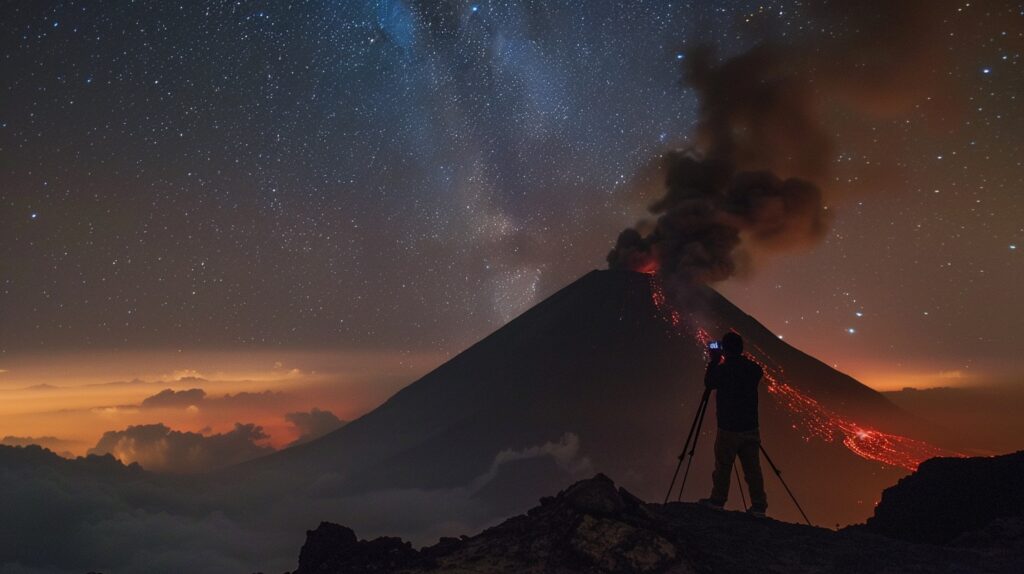
Capturing the awe-inspiring beauty of Volcán de Fuego and its surroundings requires a blend of preparation, patience, and timing. Here are essential tips to help you take breathtaking photos of this majestic volcano and its stunning landscapes.
Understanding Your Subject
Volcán de Fuego is one of Central America’s most active volcanoes. Please familiarize yourself with its activity patterns to capture dramatic eruptions and lava flows safely.
The weather can change quickly, affecting visibility. Clear mornings and late afternoons often provide the best clarity for capturing the volcano.
Equipment Essentials
A DSLR or mirrorless camera with manual settings will give you control over exposure, which is essential for varied lighting conditions. Wide-angle lenses are great for landscapes, while telephoto lenses help capture distant eruptions.
A tripod is critical for stability during long exposures, especially in low light conditions or when capturing the lava glow at night.
A polarizing filter can help reduce glare and enhance the sky’s blue. In contrast, neutral density filters allow for longer exposures during daylight.
Best Times of Day for Photography
- Golden Hour: Just after sunrise or before sunset, the golden hour offers soft, warm light that can dramatically enhance your volcanic landscapes.
- Blue Hour: The time just before sunrise or just after sunset provides an excellent, ethereal light that contrasts beautifully with the warm glow of lava.
- Night Photography: To capture the volcano’s glow against the night sky, aim for clear, moonless nights. Long exposures can reveal stunning details in both the lava and the stars.
Composition and Technique
- Foreground Interest: Use elements like vegetation, rocks, or structures to add depth and interest to your compositions.
- Silhouettes: Positioning the volcano against the sky during sunrise or sunset can create powerful silhouettes and highlight the smoke or ash plumes.
- Long Exposures: Experiment with long exposures to capture the flowing movement of lava or the trails of incandescent material during eruptions.
- Safety First: Always prioritize safety. Keep a safe distance and be aware of prevailing winds to avoid hazardous ash.
Photographing Volcán de Fuego offers a unique opportunity to capture nature’s power and beauty. By following these tips and respecting local guidelines and communities, you can create stunning images that tell the story of this remarkable landscape. Remember, the best photographs come from understanding your subject, being patient, and always being prepared for the moment.
Guided Tours vs. Independent Exploration
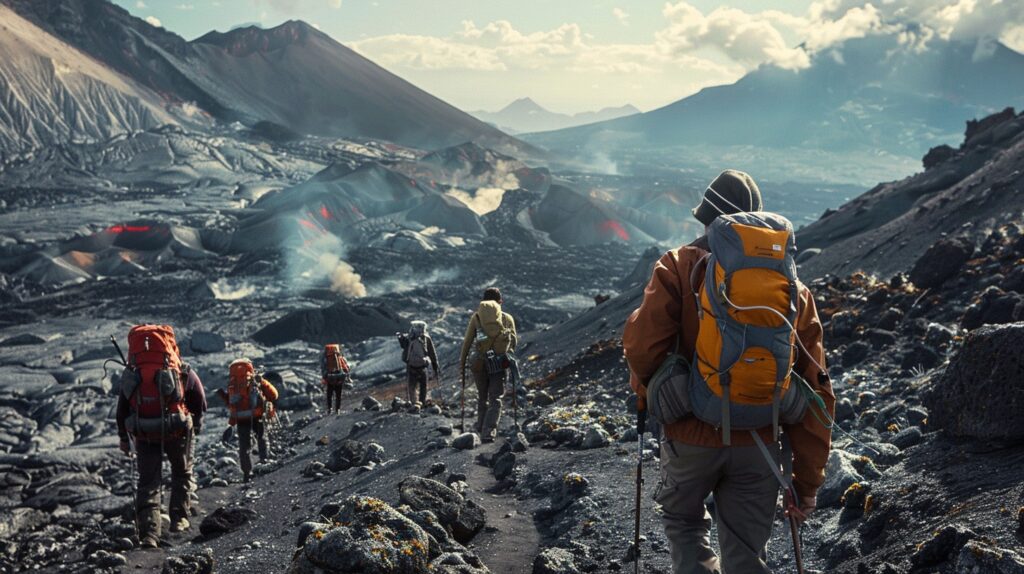
When planning a visit to Volcán de Fuego, one of the primary considerations is whether to join a guided tour or to embark on an independent exploration. Both options have advantages and drawbacks, and the best choice depends on your preferences, experience, and comfort level with adventure.
Guided Tours
Pros:
- Expert Guidance: Guides offer invaluable knowledge about the volcano’s history, geology, and the best paths for exploration, enhancing your overall experience.
- Safety: Guided tours ensure safety measures are in place, which is especially important given the unpredictable nature of an active volcano.
- Convenience: Organized tours handle logistics, including transportation and permits, allowing you to focus solely on the experience.
- Social Experience: Tours provide a social setting to meet fellow adventurers and share the experience.
Cons:
- Cost: Guided tours can be more expensive than independent hiking, especially for solo travellers or those on a tight budget.
- Less Flexibility: Scheduled tours follow a set itinerary, which might not align with your preferences for pace and exploration.
- Group Dynamics: The pace and enjoyment of the hike can be affected by the group’s overall fitness and interest levels.
Independent Exploration
Pros:
- Flexibility: Explore at your own pace, spend more time at preferred spots, and choose your route.
- Adventure: For experienced hikers, planning and executing an independent hike can add to the adventure and sense of achievement.
- Cost-Effective: Independent hiking typically costs less, as you only cover your expenses without the added fees of a guided tour.
Cons:
- Safety Risks: Without the guidance of an experienced local, you’re more exposed to potential hazards, including navigational errors and volcanic activity.
- Logistical Challenges: You’re responsible for managing all logistics, from securing permits to understanding the best times and routes for hiking.
- Missed Insights: With a guide, you might learn about the volcano’s history, geology, and ecosystems.
Tips for Adventurers Considering an Independent Hike
- Research Thoroughly: Familiarize yourself with the trails, weather conditions, and volcanic activity reports.
- Prepare Adequately: Ensure you have the right gear, including navigation tools, and understand the physical demands of the hike.
- Stay Informed: Keep up-to-date with the latest advisories from local authorities regarding volcanic activity and weather conditions.
- Leave a Plan: Inform someone of your hiking plan, including expected return time, and check in upon completion.
- Consider Hiring a Local Guide: For a middle ground between a fully guided tour and going entirely solo, consider hiring a local guide for personalized insights while maintaining some flexibility.
Deciding between a guided tour and independent exploration at Volcán de Fuego ultimately comes down to your preferences, experience level, and appetite for adventure. Regardless of your choice, witnessing one of Guatemala’s most awe-inspiring natural wonders is an unforgettable adventure.
Conclusion: Embrace the Adventure at Volcán de Fuego
Venturing to Volcán de Fuego offers more than an exhilarating hike; it presents a unique opportunity to witness Earth’s natural forces’ raw, untamed beauty. As you plan your journey to one of Guatemala’s most iconic landmarks, remember that this adventure is as much about the journey as it is about the destination.
Respect for Nature and Local Communities
- Leave No Trace: Always adhere to Leave No Trace principles to preserve this magnificent landscape for future generations.
- Support Local: Engage with and support the local communities. Your contribution can make a significant difference, whether hiring local guides or purchasing local products.
- Respect Local Communities: Volcán de Fuego is surrounded by communities deeply affected by its eruptions. Be respectful, seek permission when crossing private lands, and consider contributing to local conservation efforts or community projects.
- Cultural Sensitivity: Recognize the volcano’s significant cultural importance to local communities. Listen and learn from their stories and experiences with respect and openness.
- Stay Informed: Respect any advisories or regulations established by local authorities to protect the environment and visitors.
Exploring Volcán de Fuego is an adventure that calls to the heart of those who seek to experience our planet’s raw beauty and power. Whether you’re trekking through the lush landscapes surrounding the volcano, photographing its fiery eruptions, or simply standing in awe of its majesty, the memories you create here will last a lifetime.
As you embark on this journey, remember to tread lightly, respect the environment, and embrace every moment. The adventure that awaits you at Volcán de Fuego is not just about reaching the summit; it’s about the stories you’ll tell, the challenges you’ll overcome, and the undeniable beauty you’ll witness along the way. So pack your bags, lace up your boots, and embark on an adventure that promises to be nothing short of transformative.
FAQ
What is the current activity level of Volcán de Fuego?
Volcán de Fuego is one of Central America’s most active volcanoes. Its activity levels can vary, so it’s crucial to consult the Guatemalan Institute of Volcanology for the latest updates before planning your trip.
Is it safe to hike Volcán de Fuego?
Hiking Volcán de Fuego can be safe with the proper precautions and guidance. Always check current volcanic activity reports and consider hiring a knowledgeable local guide.
What are the permit requirements for hiking Volcán de Fuego?
Currently, Guatemala does not require permits to hike Volcán de Fuego. However, regulations can change, so you should inquire with local authorities or tour operators before your hike.
Can I camp near Volcán de Fuego?
Camping is allowed in designated areas near Volcán de Fuego. To minimize your impact, follow all guidelines and respect the environment.
How do I reach Volcán de Fuego from Guatemala City?
Volcán de Fuego is approximately 2-3 hours from Guatemala City. You can rent a car, take a bus to Antigua, and then arrange transportation to the volcano’s base through a tour operator or local taxi service.
What should I pack for a day hike to Volcán de Fuego?
For a day hike, pack light but bring essentials: water, snacks, sun protection, a hat, sturdy hiking boots, a first aid kit, layers for changing weather, and a rain jacket.
Are there any cultural considerations I should be aware of?
Respect the local communities and customs. When visiting sacred sites or interacting with locals, be mindful and considerate of their traditions and beliefs.
What wildlife might I see around Volcán de Fuego?
The region around Volcán de Fuego is home to various wildlife, including birds like the resplendent quetzal, mammals such as the puma and ocelot, and a wide array of insects and reptiles.
How can I stay updated on the volcano’s activity?
The Guatemalan Institute of Volcanology (INSIVUMEH) provides regular updates on volcanic activity. Additionally, local tour operators and park authorities are valuable resources for current conditions.
What are the best practices for environmentally responsible hiking on Volcán de Fuego?
Follow Leave No Trace principles: pack out all trash, stay on marked trails, minimize campfire impacts, and respect wildlife and plants. Your efforts help preserve the beauty of Volcán de Fuego for future generations.
Join the Club Tripsters Community

Subscribe to stay up to date with the latest:
We hope that this guide has inspired you and equipped you with practical tips for your next adventure. The Club Tripsters community thrives on sharing and learning from each other’s travel experiences. We’re eager to hear about your finds in Paris. Did you come across an exceptional yet affordable restaurant, a lesser-known shopping haven, or a hotel that surprised you with its value? Share your discoveries and tales in the comments below.
But don’t let the journey end here. Our Club Tripsters website is brimming with articles filled with travel insights—from detailed destination guides and thoughtful hotel reviews to savvy travel tips and hacks. Whether your next destination is Rome, New York, Tokyo, or somewhere else entirely, we’re here to support you with seasoned advice and genuine insider knowledge.
So, why not become a part of the Club Tripsters community today? Together, we can explore the vast world of travel, making it more achievable and fulfilling for everyone. We’re excited to hear about your travel stories.
Happy travels, and see you in the Club Tripsters community!
Wanderlust Gifts
-
 Amsterdam, Multicolor Coffee Mug$12.56 – $15.98
Amsterdam, Multicolor Coffee Mug$12.56 – $15.98 -
 Joshua Tree, Multicolor Coffee Mug$12.56 – $15.98
Joshua Tree, Multicolor Coffee Mug$12.56 – $15.98 -
 Santorini, Greece, Multicolor Coffee Mug$12.56 – $15.98
Santorini, Greece, Multicolor Coffee Mug$12.56 – $15.98
-
 Nazca Lines in Peru, Premium Matte Paper Wooden Framed Poster$43.27 – $165.28
Nazca Lines in Peru, Premium Matte Paper Wooden Framed Poster$43.27 – $165.28 -
 Amsterdam, Premium Matte Paper Wooden Framed Poster$43.26 – $165.28
Amsterdam, Premium Matte Paper Wooden Framed Poster$43.26 – $165.28 -
 Santorini, Premium Matte Paper Wooden Framed Poster$43.26 – $165.28
Santorini, Premium Matte Paper Wooden Framed Poster$43.26 – $165.28
Our articles may include affiliate links. This means that we receive a small commission should you decide to purchase anything via these links. It does not incur any additional costs to you but enables us to further our contributions to meaningful projects in noteworthy locations.
Image Disclaimer: Please note that the images used in this article are intended to evoke the mood and atmosphere associated with topic of the article. They are illustrative and do not necessarily depict the exact locations, people or experiences described in the text. Actual amenities, services, and views may vary. We recommend checking with the specific providers and operators for accurate information and visuals.
